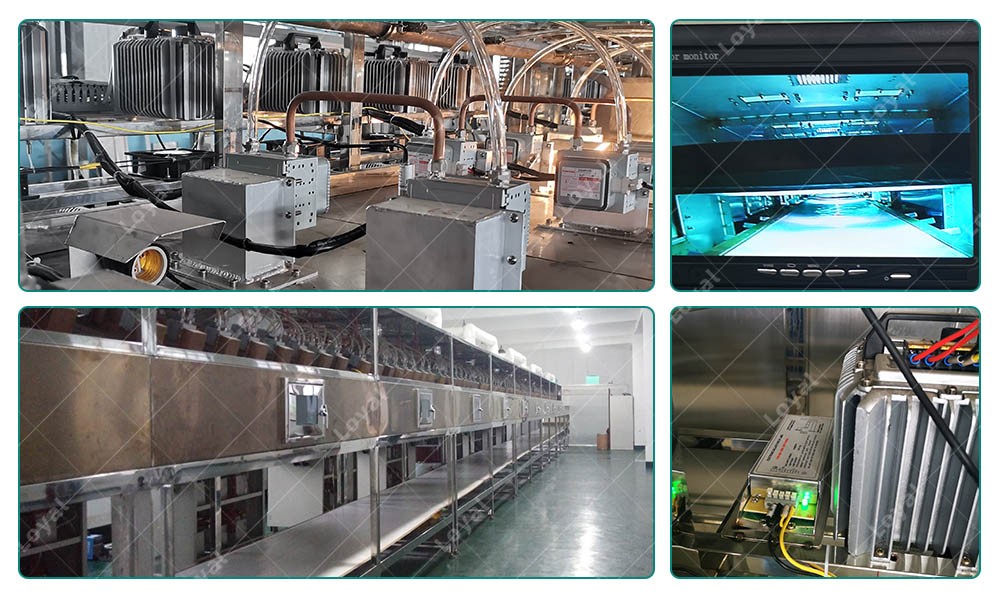Seafood Drying Microwave Oven
Description Of Seafood Drying Oven
A seafood drying oven is a specialized piece of equipment used to dry seafood products such as fish, shrimp, and squid. It is typically designed with a horizontal airflow system that allows for even drying of the seafood products. The oven usually has multiple trays or racks for placing the seafood, which are stacked one above the other.
The seafood drying oven is commonly used in the seafood processing industry to reduce the moisture content of seafood products, which increases their shelf life and makes them easier to transport and store. The oven works by circulating hot air around the seafood, which causes the moisture in the product to evaporate.
The oven typically has a temperature control system that allows the operator to set the desired temperature for drying the seafood. The temperature and drying time may vary depending on the type and thickness of the seafood product.
Overall, a seafood drying oven is a crucial piece of equipment for the seafood processing industry, as it helps to preserve and enhance the quality of seafood products for consumers.

How To Dry The Seafood
Drying seafood in a microwave or a dehydrator is possible, but it requires some caution to ensure that the seafood is properly dried and safe to eat.
When using a microwave, it's important to use low power settings and to check the seafood frequently to avoid overcooking. Place the seafood on a microwave-safe dish and cover it with a microwave-safe cover or paper towel.
Cook the seafood on low power settings, checking it frequently to ensure that it's drying evenly and not becoming overcooked. The time required for drying seafood in a microwave will depend on the type of seafood and the power of the microwave, so it's important to be patient and monitor the process closely.
Using a dehydrator is another option for drying seafood. To use a dehydrator, place the seafood on the dehydrator racks and follow the manufacturer's instructions for drying seafood. Typically, seafood should be dried at a temperature of around 145°F (63°C) to ensure that it's safe to eat. It's important to monitor the seafood frequently to ensure that it's drying evenly and to avoid over-drying it.
Regardless of the method used, it's important to ensure that the seafood is properly cleaned and prepared before drying. This includes removing any bones, skin, or other non-edible parts, as well as thoroughly cleaning the seafood to remove any dirt, debris, or bacteria. It's also important to store the dried seafood in an airtight container in a cool, dry place to prevent moisture from re-entering and spoiling the seafood.

Features Of Microwave Drying
|
Uniform Heating |
As microwave acts on water molecules, so the part with high water content absorbs more microwave power than the part with lower water content. This is the characteristic of selective heating, using this feature can achieve uniform heating and uniform drying. |
|
High Efficiency And Energy Saving |
Microwave is directly on the role of materials, so there is no additional heat loss, the air in the furnace and the corresponding container will not heat, so the thermal efficiency is very high, the production environment is also significantly improved, compared with far infrared heating can save 30% of electricity. |
|
High Efficiency Short Time |
Because microwave heating does not require the process of heat conduction, so the microwave penetrates the object from different directions into the object inside, from inside to outside so that the material in a very short time to achieve uniform drying, effectively shortening the drying time. |
|
Easy To Control |
Compared with conventional methods, microwave operation is easy; microwave power adjustable, adjustable transmission speed. |
 Advantages Of Seafood Drying Oven
Advantages Of Seafood Drying Oven
|
Faster Drying Time |
A microwave dehydrator can dry seafood much faster than traditional air-drying methods. This is because the microwaves penetrate the food and evaporate moisture more quickly. |
|
Retains Nutrients |
Microwaving seafood for dehydration helps to retain more of its natural nutrients than other drying methods. This is because the drying process is quicker, which means less heat exposure. |
|
Reduced Risk Of Spoilage |
Because the drying process is faster, there is less chance of spoilage during the drying process, which can occur with slower drying methods. |
|
Saves Energy |
Using a microwave dehydrator to dry seafood uses less energy than other drying methods, such as using a conventional oven or a food dehydrator. This can save you money on your energy bills. |
|
Easy To Use |
Microwave dehydrators are typically compact and easy to use. They require minimal setup time and are often as simple as placing the seafood in the microwave and setting the timer. |

Seafood Product Display
Seafood products refer to any type of food that comes from the sea, including fish, shellfish, and other sea creatures. Some common examples of seafood products include salmon, tuna, shrimp, crab, lobster, oysters, mussels, and scallops.Seafood is known for being a rich source of protein, vitamins, and minerals, particularly omega-3 fatty acids which are essential for maintaining a healthy heart and brain. It is also a low-fat source of protein which makes it a popular choice for people who are trying to maintain a healthy diet.There are many ways to prepare seafood products, including grilling, baking, frying, and boiling. Seafood is often served as a main course in restaurants or as an ingredient in dishes such as sushi, chowder, and seafood salads. It is also available in various forms such as canned, frozen, or fresh.
